Ding Chen
Over-The-Air Phase Calibration of Spaceborne Phased Array for LEO Satellite Communications
Oct 09, 2025Abstract:To avoid the unpredictable phase deviations of the spaceborne phased array (SPA), this paper considers the over-the-air (OTA) phase calibration of the SPA for the low earth orbit (LEO) satellite communications, where the phase deviations of the SPA and the unknown channel are jointly estimated with multiple transmissions of the pilots. Moreover, the Cramer Rao Bound (CRB) is derived, and the optimization of beam patterns is also presented to lower the root mean squared error (RMSE) of the OTA calibration. The simulation results verify the effectiveness of the proposed OTA phase calibration algorithm as the RMSEs of the phase estimates closely approach the corresponding CRB, and the beam pattern optimization scheme is also validated for more than 4dB gain of SNR over the randomly generated beam patterns.
GuessArena: Guess Who I Am? A Self-Adaptive Framework for Evaluating LLMs in Domain-Specific Knowledge and Reasoning
May 28, 2025Abstract:The evaluation of large language models (LLMs) has traditionally relied on static benchmarks, a paradigm that poses two major limitations: (1) predefined test sets lack adaptability to diverse application domains, and (2) standardized evaluation protocols often fail to capture fine-grained assessments of domain-specific knowledge and contextual reasoning abilities. To overcome these challenges, we propose GuessArena, an adaptive evaluation framework grounded in adversarial game-based interactions. Inspired by the interactive structure of the Guess Who I Am? game, our framework seamlessly integrates dynamic domain knowledge modeling with progressive reasoning assessment to improve evaluation fidelity. Empirical studies across five vertical domains-finance, healthcare, manufacturing, information technology, and education-demonstrate that GuessArena effectively distinguishes LLMs in terms of domain knowledge coverage and reasoning chain completeness. Compared to conventional benchmarks, our method provides substantial advantages in interpretability, scalability, and scenario adaptability.
MemOS: An Operating System for Memory-Augmented Generation (MAG) in Large Language Models
May 28, 2025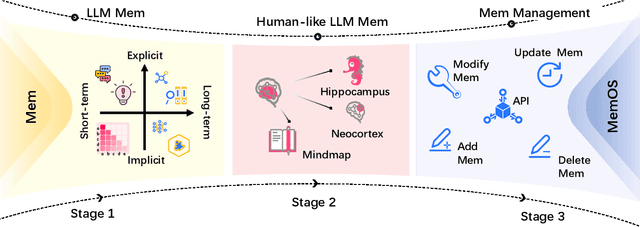
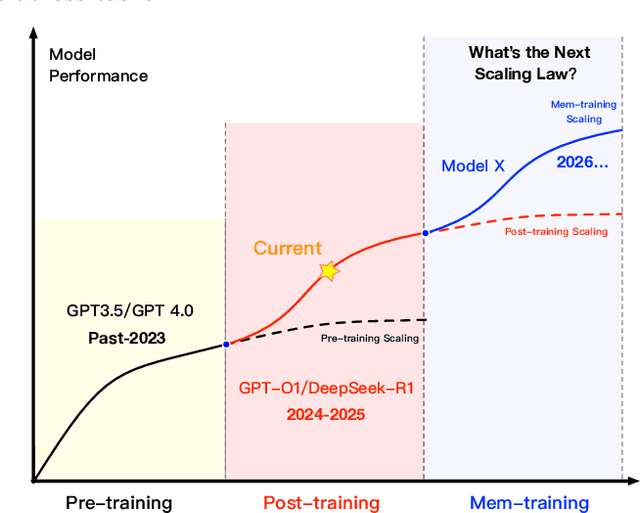
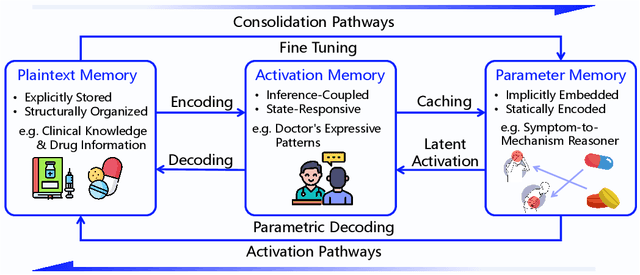
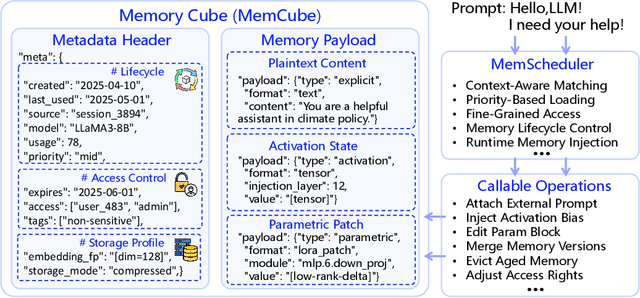
Abstract:Large Language Models (LLMs) have emerged as foundational infrastructure in the pursuit of Artificial General Intelligence (AGI). Despite their remarkable capabilities in language perception and generation, current LLMs fundamentally lack a unified and structured architecture for handling memory. They primarily rely on parametric memory (knowledge encoded in model weights) and ephemeral activation memory (context-limited runtime states). While emerging methods like Retrieval-Augmented Generation (RAG) incorporate plaintext memory, they lack lifecycle management and multi-modal integration, limiting their capacity for long-term knowledge evolution. To address this, we introduce MemOS, a memory operating system designed for LLMs that, for the first time, elevates memory to a first-class operational resource. It builds unified mechanisms for representation, organization, and governance across three core memory types: parametric, activation, and plaintext. At its core is the MemCube, a standardized memory abstraction that enables tracking, fusion, and migration of heterogeneous memory, while offering structured, traceable access across tasks and contexts. MemOS establishes a memory-centric execution framework with strong controllability, adaptability, and evolvability. It fills a critical gap in current LLM infrastructure and lays the groundwork for continual adaptation, personalized intelligence, and cross-platform coordination in next-generation intelligent systems.
xVerify: Efficient Answer Verifier for Reasoning Model Evaluations
Apr 14, 2025Abstract:With the release of the o1 model by OpenAI, reasoning models adopting slow thinking strategies have gradually emerged. As the responses generated by such models often include complex reasoning, intermediate steps, and self-reflection, existing evaluation methods are often inadequate. They struggle to determine whether the LLM output is truly equivalent to the reference answer, and also have difficulty identifying and extracting the final answer from long, complex responses. To address this issue, we propose xVerify, an efficient answer verifier for reasoning model evaluations. xVerify demonstrates strong capability in equivalence judgment, enabling it to effectively determine whether the answers produced by reasoning models are equivalent to reference answers across various types of objective questions. To train and evaluate xVerify, we construct the VAR dataset by collecting question-answer pairs generated by multiple LLMs across various datasets, leveraging multiple reasoning models and challenging evaluation sets designed specifically for reasoning model assessment. A multi-round annotation process is employed to ensure label accuracy. Based on the VAR dataset, we train multiple xVerify models of different scales. In evaluation experiments conducted on both the test set and generalization set, all xVerify models achieve overall F1 scores and accuracy exceeding 95\%. Notably, the smallest variant, xVerify-0.5B-I, outperforms all evaluation methods except GPT-4o, while xVerify-3B-Ib surpasses GPT-4o in overall performance. These results validate the effectiveness and generalizability of xVerify.
Differentially Private Neural Network Training under Hidden State Assumption
Jul 11, 2024


Abstract:We present a novel approach called differentially private stochastic block coordinate descent (DP-SBCD) for training neural networks with provable guarantees of differential privacy under the hidden state assumption. Our methodology incorporates Lipschitz neural networks and decomposes the training process of the neural network into sub-problems, each corresponding to the training of a specific layer. By doing so, we extend the analysis of differential privacy under the hidden state assumption to encompass non-convex problems and algorithms employing proximal gradient descent. Furthermore, in contrast to existing methods, we adopt a novel approach by utilizing calibrated noise sampled from adaptive distributions, yielding improved empirical trade-offs between utility and privacy.
HRDE: Retrieval-Augmented Large Language Models for Chinese Health Rumor Detection and Explainability
Jun 30, 2024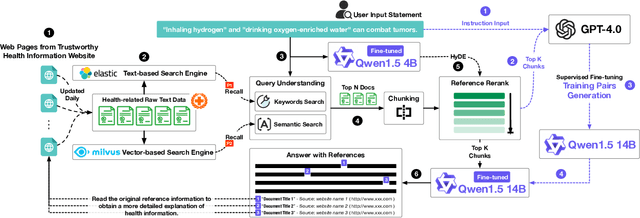


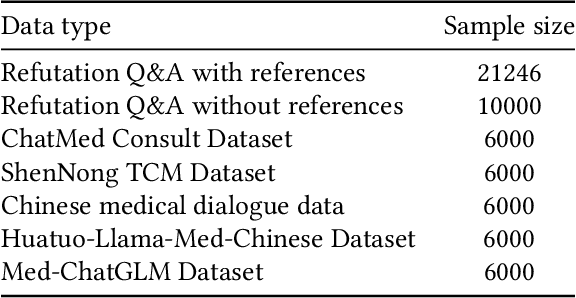
Abstract:As people increasingly prioritize their health, the speed and breadth of health information dissemination on the internet have also grown. At the same time, the presence of false health information (health rumors) intermingled with genuine content poses a significant potential threat to public health. However, current research on Chinese health rumors still lacks a large-scale, public, and open-source dataset of health rumor information, as well as effective and reliable rumor detection methods. This paper addresses this gap by constructing a dataset containing 1.12 million health-related rumors (HealthRCN) through web scraping of common health-related questions and a series of data processing steps. HealthRCN is the largest known dataset of Chinese health information rumors to date. Based on this dataset, we propose retrieval-augmented large language models for Chinese health rumor detection and explainability (HRDE). This model leverages retrieved relevant information to accurately determine whether the input health information is a rumor and provides explanatory responses, effectively aiding users in verifying the authenticity of health information. In evaluation experiments, we compared multiple models and found that HRDE outperformed them all, including GPT-4-1106-Preview, in rumor detection accuracy and answer quality. HRDE achieved an average accuracy of 91.04% and an F1 score of 91.58%.
xFinder: Robust and Pinpoint Answer Extraction for Large Language Models
May 23, 2024Abstract:The continuous advancement of large language models (LLMs) has brought increasing attention to the critical issue of developing fair and reliable methods for evaluating their performance. Particularly, the emergence of subjective or non-subjective cheating phenomena, such as test set leakage and prompt format overfitting, poses significant challenges to the reliable evaluation of LLMs. Since evaluation frameworks often utilize Regular Expression (RegEx) for answer extraction, some models may adjust their responses to comply with specific formats that are easily extractable by RegEx. Nevertheless, the key answer extraction module based on RegEx frequently suffers from extraction errors. This paper conducts a comprehensive analysis of the entire LLM evaluation chain, demonstrating that optimizing the key answer extraction module can improve extraction accuracy, reduce LLMs' reliance on specific answer formats, and enhance the reliability of LLM evaluation. To address these issues, we propose xFinder, a model specifically designed for key answer extraction. As part of this process, we create a specialized dataset, the Key Answer Finder (KAF) dataset, to ensure effective model training and evaluation. Through generalization testing and evaluation in real-world scenarios, the results demonstrate that the smallest xFinder model with only 500 million parameters achieves an average answer extraction accuracy of 93.42%. In contrast, RegEx accuracy in the best evaluation framework is 74.38%. xFinder exhibits stronger robustness and higher accuracy compared to existing evaluation frameworks.
Noisy Spiking Actor Network for Exploration
Mar 07, 2024Abstract:As a general method for exploration in deep reinforcement learning (RL), NoisyNet can produce problem-specific exploration strategies. Spiking neural networks (SNNs), due to their binary firing mechanism, have strong robustness to noise, making it difficult to realize efficient exploration with local disturbances. To solve this exploration problem, we propose a noisy spiking actor network (NoisySAN) that introduces time-correlated noise during charging and transmission. Moreover, a noise reduction method is proposed to find a stable policy for the agent. Extensive experimental results demonstrate that our method outperforms the state-of-the-art performance on a wide range of continuous control tasks from OpenAI gym.
Grimoire is All You Need for Enhancing Large Language Models
Jan 10, 2024Abstract:In-context Learning (ICL) is one of the key methods for enhancing the performance of large language models on specific tasks by providing a set of few-shot examples. However, the ICL capability of different types of models shows significant variation due to factors such as model architecture, volume of learning data, and the size of parameters. Generally, the larger the model's parameter size and the more extensive the learning data, the stronger its ICL capability. In this paper, we propose a method SLEICL that involves learning from examples using strong language models and then summarizing and transferring these learned skills to weak language models for inference and application. This ensures the stability and effectiveness of ICL. Compared to directly enabling weak language models to learn from prompt examples, SLEICL reduces the difficulty of ICL for these models. Our experiments, conducted on up to eight datasets with five language models, demonstrate that weak language models achieve consistent improvement over their own zero-shot or few-shot capabilities using the SLEICL method. Some weak language models even surpass the performance of GPT4-1106-preview (zero-shot) with the aid of SLEICL.
Fully Spiking Actor Network with Intra-layer Connections for Reinforcement Learning
Jan 09, 2024Abstract:With the help of special neuromorphic hardware, spiking neural networks (SNNs) are expected to realize artificial intelligence (AI) with less energy consumption. It provides a promising energy-efficient way for realistic control tasks by combining SNNs with deep reinforcement learning (DRL). In this paper, we focus on the task where the agent needs to learn multi-dimensional deterministic policies to control, which is very common in real scenarios. Recently, the surrogate gradient method has been utilized for training multi-layer SNNs, which allows SNNs to achieve comparable performance with the corresponding deep networks in this task. Most existing spike-based RL methods take the firing rate as the output of SNNs, and convert it to represent continuous action space (i.e., the deterministic policy) through a fully-connected (FC) layer. However, the decimal characteristic of the firing rate brings the floating-point matrix operations to the FC layer, making the whole SNN unable to deploy on the neuromorphic hardware directly. To develop a fully spiking actor network without any floating-point matrix operations, we draw inspiration from the non-spiking interneurons found in insects and employ the membrane voltage of the non-spiking neurons to represent the action. Before the non-spiking neurons, multiple population neurons are introduced to decode different dimensions of actions. Since each population is used to decode a dimension of action, we argue that the neurons in each population should be connected in time domain and space domain. Hence, the intra-layer connections are used in output populations to enhance the representation capacity. Finally, we propose a fully spiking actor network with intra-layer connections (ILC-SAN).
 Add to Chrome
Add to Chrome Add to Firefox
Add to Firefox Add to Edge
Add to Edge